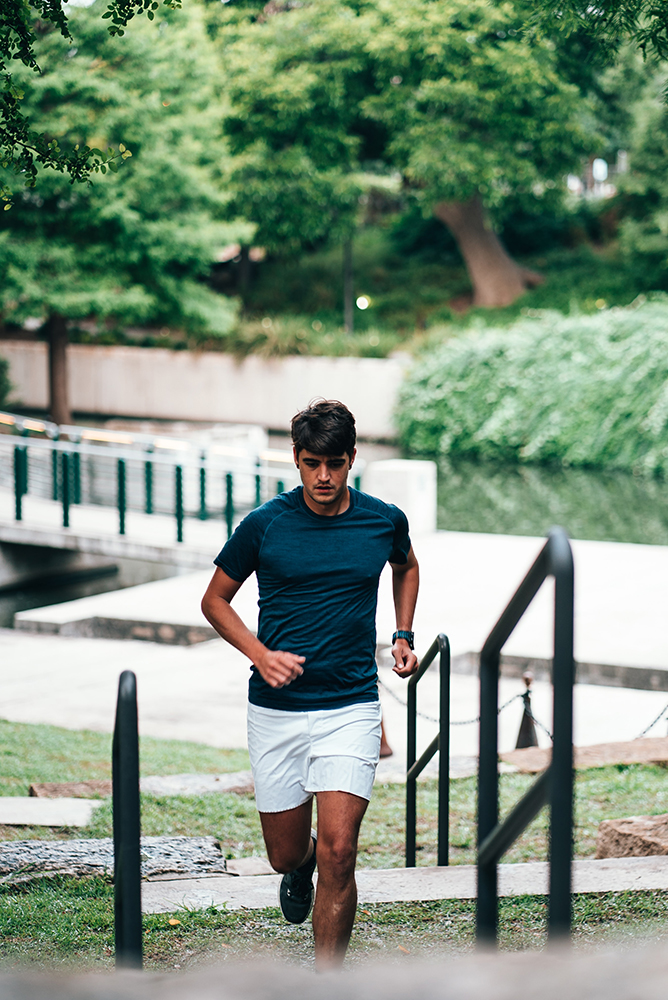


With gyms and fitness studios still being closed (and for good reason) you’re probably looking for new ways to stay active while staying home. However, now that summer is in full swing there’s a couple of things you want to be careful of now that the temperatures are rising. Heat exhaustion, heat cramps, and heat stroke are real and should be avoided at all costs.
For your body to adapt to increasing temperatures it requires thermoregulation, which is the maintenance or regulation of temperature. Hence why we sweat and have increased blood flow when we get hot. However, thermoregulation becomes less effective in high temperatures. To stay safe this summer we’ve rounded up warning signs, the differences of heat-related illness, and 6 easy tips for working out in hot weather. Also, be sure to continue wearing masks as COVID-19 is far from over despite countries reopening.
Heat Cramps:
Heat cramps are painful muscle cramps/contractions that can happen during exercise. The muscles that are affected may feel tight or inflamed to the physical touch. However, your body temperature may remain normal.
Heat Exhaustion:
When heat exhaustion occurs, your body temperature may rise to 104 F (40 C) and you can experience weakness, headache, fainting, nausea, vomiting, sweaty, or cold skin. If heat exhaustion isn’t treated, it can lead to heat stroke.
Heat Stroke:
Heatstroke is an extremely serious and life-threatening condition that happens when your body temperature is higher than 104 F (40 C). You can experience confusion, irritability, heart rhythm changes, dizziness, visual problems, and vomiting. If this is left untreated you’re at severe risk for brain damage, organ failure, or worse, fatality.
Warning Symptoms for Heat Illness:
Muscle cramps, nausea, vomiting, weakness, fatigue, headache, excessive sweating, dizziness, irritability, low blood pressure, visual issues, and confusion.
6 Tips for Exercising Safely In Hot Weather:
Weather Check
It’s highly important to pay attention to the weather and heat alerts during the summer. Knowing what the expected temperature is going to be during your outdoor activities is extremely helpful and can keep yourself out of a dangerous situation. “Exercising in temperatures higher than 91.4°F can increase the risk of heat exhaustion. And when it’s humid, it’s harder for your body to cool itself. When the sweat on your skin evaporates, it takes heat away with it. This is why humidity feels hotter than dry heat. Less evaporation occurs when the air is already saturated with moisture,” says Heather Milton, MS, RCEP, CSCS, an exercise physiologist at NYU Langone’s Sports Performance Center.
2. Wear Sunscreen
Wearing sunscreen helps with the prevention of skin cancer or skin aging, but the Mayo Clinic pointed out that being sunburnt “decreases your body’s ability to cool itself.”
3. Slow Down
If you’re used to working out in cool indoor spaces, acclimating yourself is an important part of taking your workout routine outside. Take it easy, slow down, and allow your body to adapt to the new elements. It may take a few weeks for your body to adjust. Until then, slowly increase the intensity and duration of your workouts.
4. Dress Accordingly
Stay away from workout clothes made out of cotton or heavy materials. You want something that’s sweat-wicking usually consisting of microfiber polyester. Stay away from dark colors due to their ability to absorb heat.
5. Always Avoid Midday Heat
Being outside in midday heat when the sun is directly overhead is something you want to avoid, especially if exercising. Instead, try working out in the morning or evening when it’s cooler. However, if you don’t have that option, find a shady spot to protect yourself.
6. Keep Drinking Water
Dehydration is a key component of heat-related injuries. By staying hydrated you are massively helping your body sweat and cool down. Be sure to continue drinking water and don’t wait until you feel thirsty. If you’re planning on doing an intense workout be sure to drink electrolytes instead of water.
ジムやフィットネススタジオがまだクローズされている中で、恐らくあなたはこれまでとは違う形でアクティブな状態を保つための新しい方法を模索されている事でしょう。ただ、本格的に夏を迎えようとしている今、気温が上昇しているため、注意すべきことがいくつかあります。熱疲労、熱けいれん、および熱中症は現実的なものであり、回避する必要があります。
体が温度の上昇に順応するには、体温調節が必要です。これは、体温の維持または調節です。 なぜ私たちは汗をかくのか、暑くなると血流が増えるからです。 ただし、温度調節は高温では効果が低くなります。この夏は、安全を確保するために、注意すべき点や熱に関連する症状の違い、暑い季節に運動するための6つの簡単なヒントをまとめました。また、COVID-19は国々で色々なところが再開していますが、まだ終わっていないので、必ずマスクを着用してください。
熱けいれん:
熱性けいれんは、運動中に起こり得る痛みを伴う筋肉のけいれん/収縮です。 影響を受ける筋肉は、炎症を起こしているかもしれません。 ただし、体温は正常なままです。
熱疲労:
熱中症が発生すると、体温が104°F(40℃)に上昇し、脱力感、頭痛、失神、吐き気、嘔吐、汗、冷肌を経験する可能性があります。 熱疲労は、熱中症につながる可能性があります。
熱中症:
体温が104°F(40℃)を超えると、熱中症の中でも非常に深刻で生命を脅かす状態です。混乱、過敏、心臓のリズムの変化、めまい、視覚障害、嘔吐を経験することが これを治療せずに放置すると、脳の損傷、臓器不全、さらには致命的な危険にさらされます。
暑い季節に安全に運動するための6つのヒント:
1.天気チェック
夏の間の天気と熱に関する警報に注意を払うことは非常に重要です。 野外活動中の予想温度を知ることは非常に役立ち、危険な状況から身を守ることができます。 「91.4°F(33℃)を超える温度で運動すると、熱中症のリスクが高まります。 湿度が高いと、体が冷えるのが難しくなります。 皮膚の汗が蒸発すると、熱が奪われます。 このため、湿度は乾熱よりも熱く感じられます。 空気がすでに湿気で飽和している場合、蒸発は少なくなります」Heather Milton、NYU Langone’s Sports Performance Center の運動生理学者。
2.日焼け止めを使用してください
日焼け止めを塗ると、皮膚がんや皮膚の老化の予防に役立ちます。Mayo Clinicは、日焼けしていることで自分の身体を冷やす能力が低下しますと指摘されています。
3.スローダウン
涼しい室内でのエクササイズに慣れている場合は、トレーニングルーティンを屋外で行うための重要な事はリラックスして、ゆっくりと体を新しい環境に順応させてください。体の調整には数週間かかる場合があります。それまでは、ワークアウトの強度と継続時間を徐々に増やしてください。
4.状況に応じた服装
綿や重い素材で作られたトレーニング服を避けてください。通常はマイクロファイバーポリエステルでできており、汗を発散させるものが必要です。熱を吸収する能力があるため、暗い色は避けてください。
5.真昼の暑さを避ける
太陽が真上にある真昼の暑さの外にいることは、特に運動している場合は避けたいものです。代わりに、涼しい朝または夕方に運動してください。ただし、そのオプションがない場合は、影のある場所を見つけて身を守ってください。
6.水を飲み続ける
脱水症は、熱に関連した重要な要素です。水分補給を続けることで、体の汗と冷えを大幅に助けます。必ず水を飲み続け、喉が渇くまで待ってはいけません。激しいワークアウトを計画している場合は、必ず水の代わりに電解質を含む飲み物を飲んでください。